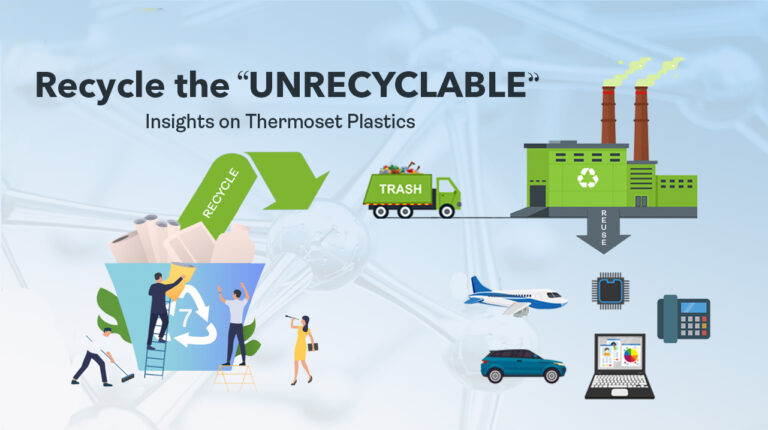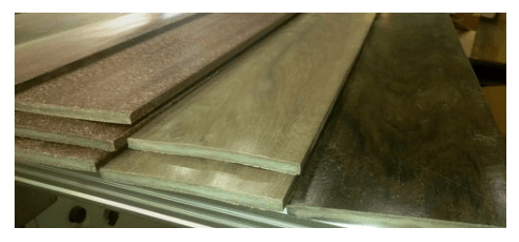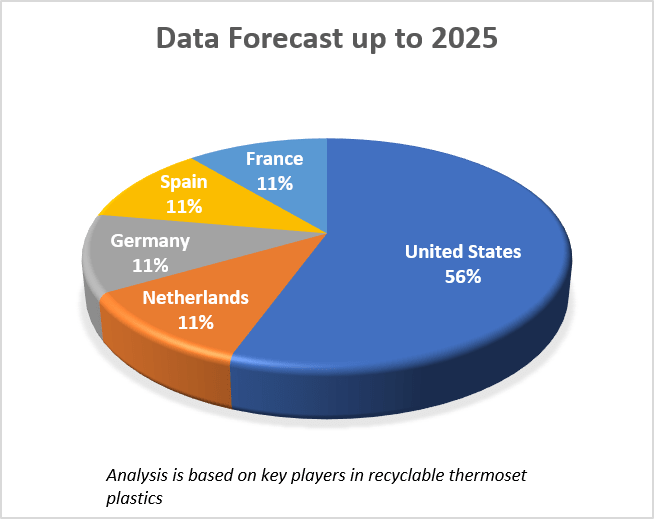Recyclable Thermoset plastics – Recycling the ‘unrecyclable’

What is common between a comb, a credit card and a Frisbee? Well, they are all plastic objects and over a period of time, plastics and humankind have had a love-hate relationship. The first synthetic plastic “Bakelite” was produced in 1907 and by 1950 the world had produced 2 million tonnes per year. Mass production of plastics began subsequently and by 2018 the global production reached 359 million metric tonnes. It was during 2018-19 that there was a worldwide revolt against plastic pollution and it translated into political and corporate action.
Plastics are considered as an environmental evil because of the havoc that plastic waste wreak. We see it them on our streets, in our rivers and lakes, on our beaches and even in our deepest oceans. Researchers estimate that there will be more plastic than fish in the ocean by 2050 if business was allowed to continue as normal.
Plastic is everywhere and is difficult to recycle because every type of plastic needs to be treated differently. Amongst the various varieties of plastics, Thermosets which is widely used in electronic devices was considered as unrecyclable till 2013. Thermoset plastics, started getting recycled from 2014. Eventually, many researches created a way to recycle disposed thermoset plastics and to manufacture recyclable thermoset plastics. The objective of this blog is to familiarize the readers about thermosets, its recyclability, its key role in the current market and the technologies behind them.
What are Thermosets?
A thermoset or thermosetting plastic are rigid polymeric materials that cross-link together, during the curing process, to form an irreversible chemical bond. The cross-linking process eliminates the risk of the product re-melting when heat is applied, making thermosets ideal for high-heat applications such as electronics and appliances.
- Thermosets are unique and quite different from traditional plastic materials such as thermoplastics as the former can withstand higher temperature without losing its structural integrity

Image credits: Buzzle.com
- As implied from its name, thermosets are set in their physical and chemical properties and therefore no longer affected by additional heat exposure, whereas thermoplastics melts and disfigures when exposed to excess heat.
Where are Thermosets utilized?
Thermoset polymers are found everywhere – in circuit boards, electrical wiring, food storage materials and of course in wide range of industries like automotive, appliance, electrical, lighting, and energy markets due to their strong and durable properties.

What are the commonly utilized thermosets?
The commonly utilized thermosets include vulcanized rubber, fiber-reinforced polymer composite, Polyester resin, Polyurethane, Melamine, Bakelite, Silicone resin, Epoxy resin etc.,
Are thermoset plastics recyclable?
In 2014, a set of international researches developed a new thermoset plastic which could be recycled. Earlier to 2014, as discussed earlier, most thermoset plastics were not considered to be recyclable. This was attributed to the fact that since thermosets cannot be broken down to its original form, one cannot re-use it to create new thermoset plastic. The discarded thermoset plastics will obviously end up in a landfill somewhere and form heaps of waste over a period of time like all landfills always do. This was the objective of the research team in 2014 was to address this issue and this led to development of a thermoset plastic that could be recycled.
What are the benefits of recycling thermosets?
Recycling thermosets could benefit the environment and industry in numerous ways which are provided below:
- Minimizes the need of manufacturing new plastic products
- Reduces the landfilling of plastics
- Reduces the greenhouse effect and global warming
- Reduces the pollution
- Conserves the natural resources
- Reduces the demand for raw materials
- Eliminates climate-changing carbon emissions
- Creates green jobs
Commercialization of recyclable thermoset plastics:
Since thermoset plastics cannot be melted / modified into new products, they can be reused for other products by reshaping them as they have greater resistance to chemicals, greater flexibility and are cost effective. The recycling involves extrusion and molding which transforms the plastics to the desired form or shape.
Below are few examples of commercial products that are manufactured from recycled thermoset plastics:
- British Company Working to Create World’s First Recycled Wetsuit

Recently, a British company is attempting to make surfing more sustainable by creating the world’s first recycled wetsuit. For sea/ocean surfers, having a good wetsuit is almost as important as having a good surfing board. A good wetsuit needs to withstand wear and tear due to U.V. rays and saltwater. Most of the wetsuits are made with neoprene, which is a thermoset. After two years of research and experiments, creators found a way to chemically re-engineer wetsuit materials so that they can be reused. Right now, it’s just a prototype. The production is still about a year and a half away. Manufacturers say when the recycled wetsuit does hit the market, it will cost the same as a regular wetsuit.
2. Epoxy/Polyester-FRP Waste for Reinforcements in Thermoplastics
Conenor invented a new composite material using a unique composition. This allows thermoset fiberglass waste to be recycled as a reinforcement. As this does not involve grinding into powder, it is used in thermoplastics like PE, PP and others Image credits: Conenor
Image credits: Conenor
3. US green chemistry company pushes ahead with commercialization of bio-based, recyclable thermoset plastics technology
US green chemistry company is pushing ahead with developing its SperoSet technology – a technology that produces lignin-based thermoset polymers that are renewable and recyclable. This company will first target its SperoSet technology for the manufacture of carbon fibre reinforced composite (CFRC) market. These high-tech composites have applications in the automotive and sporting goods industries where they are used for their high strength and low weight properties.
4. Polyspolia

Image credits: Will Yates-Johnson
Polyspolia is a proposal for a new manufacturing model in which an object can be endlessly broken up and remade. Polyspolia is a chemical process involving a traditional limitation of recycling thermosetting plastics because of its resistance to melting and requires no external energy to create a new product. The production model incorporates all of the material from the previous iteration into the new one, thus avoiding the accumulation of waste between generations. Many thermosetting plastics were incorporated in this production model, including polyurethane and polyester resins (natural inheritors to Bakelite’s phenolic resin). Various fillers of different grades were also tested, from sawdust and wood flour to calcium carbonate, aluminium hydroxide and talcum powder.
Technologies behind the Recycling of Thermoset Plastics:
Recently published Patent in United States US20180229397 to CONENOR discloses a method to recycle thermoset compositions, , such as Fibre Reinforced Plastic (FRP). The method involves the steps of: mixing thermoplastic polymer material particles and thermoset composition particles comprising cured thermoset polymer, the mixing comprising rising the temperature of the composition and at least partly melting the surface of thermoplastic polymer material particles, and simultaneously mixing the particles allowing thermoset composition particles adhere to the thermoplastic polymer material particles, and cooling the composition. The recycled product obtained from the aforementioned method is used as reinforcement in various industrial sectors like aerospace, marine, wind energy, construction and automotive.
Further, US9255172 to IBM, discloses a method of recycling a composite material component which includes obtaining a composite material component including a Polyhexahydrotriazine (PHT) resin (a thermoset polymer) and a filler element that is covalently bonded to the PHT resin, exposing the composite material component to an acid, and optionally recovering the filler element.
The PHT composite materials are attractive for applications requiring lightweight, rigid, strong, heat resistant components such as aerospace engineering, automotive components, electronics, or the like. In general, PHT materials have unique combinations of properties that include high modulus, solvent resistance, heat resistance/insensitivity, resistance to stress fracture/cracking. Additionally, unlike most thermosetting materials, PHT materials can be reverted to monomer via treatment with an acid. This allows PHT composite materials (or components formed by these materials) to be reworked or recycled to starting materials.
Top Countries that have and will invest on Recyclable Thermosets

The road ahead:
Several organizations around the globe are attempting to stimulate thermoset recycling by developing chemical processes to make thermosets completely recyclable. According to the latest market intelligence report by BIS Research titled, ‘Global Recyclable Thermoset Market-Analysis and Forecast (2017-2026),’ the global market for recyclable Thermosets is expected to reach approximately $704.1 million in the year 2026. Recycling of plastics is a social cause which has led to governments globally providing incentives to do so, as better quality of recycled materials would present a plethora of opportunities to the different end-user industries.
Read other article : Battle Between Life and Death – Edge Connected Driverless Vehicles










